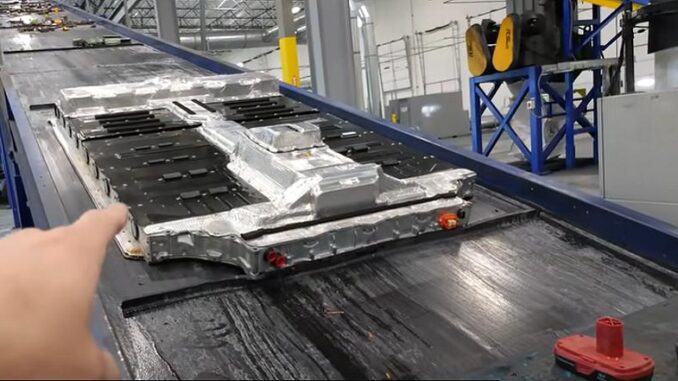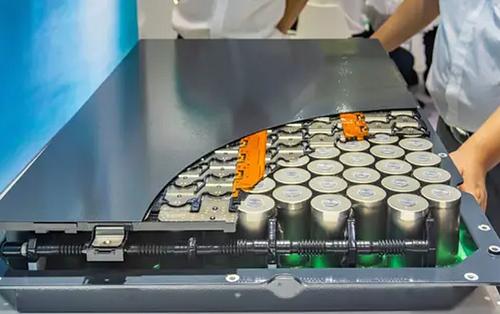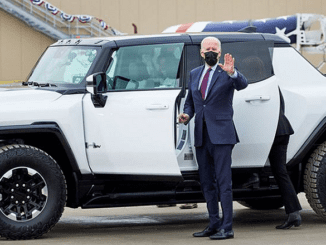
WASHINGTON DC, November 20, 2024 (ENS) – To improve the economics of recycling end-of-life electric vehicle batteries, the U.S. Department of Energy has announced $44.8 million in funding from the Bipartisan Infrastructure Law for eight projects that will lower costs of transporting, dismantling, and preprocessing electric drive vehicle batteries and components.
Among other innovations, grantees will develop, test and demonstrate:
- – a system for safely transporting second-life and defective, damaged, or recycled EV batteries that otherwise might catch fire;
- – a semi-automatic system for dismantling end-of-life EV batteries using machine learning, a subset of artificial intelligence
- – an automatic sorting and de-hazarding system for end-of-life EV batteries, and
- – compact mobile preprocessing hubs that can be deployed at local collection points to safely dismantle and shred end-of-life EV batteries.
“The United States is securing a resilient domestic battery supply chain, thanks to the Biden-Harris Administration’s historic investments in innovation and battery recycling efforts,” said U.S. Secretary of Energy Jennifer Granholm. “Finding new life for used batteries will significantly reduce pollution and our reliance on other nations, while lowering costs and supporting the clean energy transition.”
Since President Joe Biden and Vice President Kamala Harris took office in January 2021, more than four million electric vehicles have been sold in the United States – more than double the number purchased in all previous years combined.
The demand for EVs and stationary storage is projected to increase the size of the lithium battery market five-to ten-fold by the end of the decade, making U.S investments to accelerate development of a resilient domestic supply chain for high-capacity batteries essential.
With the long-term goal of lowering EV costs, the projects selected by the Department of Energy’s Vehicle Technologies Office will advance research, development, and demonstration of recycling and second-life applications for batteries once used to power EVs.
This announcement builds on $92 million in previously announced projects to advance EV battery recycling and expand its equitable deployment, supporting President Biden’s goal to have EVs make up half of all vehicle sales in America by 2030.
These investments support the Biden-Harris Administration’s Justice40 Initiative, which sets a goal that 40 percent of the overall benefits of certain federal investments in climate, clean energy, and other areas flow to disadvantaged communities that are marginalized by underinvestment and overburdened by pollution.
The eight projects selected for this round of funding are the second phase of $200 million in total provided for electric drive vehicle battery recycling and second life applications and part of $7 billion in total funding provided by President Biden and Vice President Harris’ Bipartisan Infrastructure Law to support battery supply chains.
These projects will reduce costs associated with transporting, dismantling, and preprocessing end-of-life electric drive vehicle batteries for recycling, and the recycling of plastic and polymer electric drive battery accessory components.
In September 2024, Department of Energy announced an intent to fund the third phase with up to $70 million for projects that will improve the economics of electric drive vehicle battery recovery and re-use.
The projects selected in this latest funding round are expected to improve the economics of transportation, dismantling, and preprocessing of electric drive vehicle batteries:
B2U Storage Solutions, Inc. based in Los Angeles, California, will receive $3,461,724 to design, fabricate, test, and demonstrate a low-cost, reusable, stackable, fire resistant, compliant, and real-time monitored system for transporting second-life and defective, damaged, or recycled EV batteries.
Caterpillar Inc. of Chillicothe, Illinois will receive $5,039,849 to develop a new or improved battery pack design for off-highway, heavy duty vehicle batteries that will result in a more efficient dismantling process, and explore innovative technologies to reduce labor time needed for dismantling.
General Motors of Pontiac, Michigan will receive $7,999,997 to develop and demonstrate an automatic sorting and de-hazarding system for end-of-life EV batteries, with an aim of developing techniques that can be used by automotive recyclers, dealers, and mechanic shops.
ReJoule Incorporated of Signal Hill, California will receive $6,316,383 to develop and scale a technology for EV battery diagnostics that will check for system-level safety hazards and detect damage or defects at the point of collection.
Rochester Institute of Technology of Rochester, New York will receive $7,107,540 to develop and demonstrate a process that accelerates condition assessment of collected EV batteries, and semi-automates dismantling of end-of-life EV batteries using machine learning.
Siemens Corporation, Technology of Princeton, New Jersey will receive $7,998,766 to demonstrate an automated approach for battery disassembly to reduce cost while maintaining the flexibility to handle a variety of types of battery packs.
Tennessee Technological University of Cookeville, Tennessee will receive $4,867,519 to design, develop, demonstrate, and validate innovative compact mobile preprocessing hubs that can be transported and deployed at local collection points to safely dismantle and shred end of life EV batteries.
To increase recycling of electric drive vehicle battery accessory components:
University of Akron of Akron, Ohio will receive $2,000,000 to eliminate the flow of plastics/polymers from end-of-life EV battery packs to landfills, while simultaneously retrieving and recycling them to be used as raw materials for new batteries.
Learn more about the projects selected for award negotiation. Selection for award negotiations is not a commitment by DOE to issue an award or provide funding. Before funding is issued, DOE and the applicants will negotiate, and DOE may cancel award negotiations and rescind the selection for any reason during that time. Award amounts are subject to change pending negotiations.
Trump Could Kill the EV Tax Credit
The election of Donald Trump for a second term starting January 20, 2025 is expected to change the U.S. approach to electric cars.
For one thing, Trump could eliminate Biden’s $7,500 electric vehicle tax credit. Reuters was first to report last week that Trump’s transition team plans to eliminate the tax credit.
That doesn’t phase Elon Musk, whose Tesla Motors is the state‘s and nation’s most popular electric car manufacturer. He reportedly believes that higher EV prices would his competitors more than it would hurt Tesla.
Accelerating the transition to vehicles powered by electricity, not oil and gas, has been a big policy push from California Governor Gavin Newsom and President Biden, both Democrats. To motivate drivers to switch to EVs, the Biden Administration established a $7,500 consumer tax credit – now available at the dealership as an up-front credit off the cost of the car – that saved EV buyers more than $1 billion in 2024 alone.
“More than 1.4 million light-duty plug-in vehicles were sold in the United States in 2023, more than 9% of all new light-duty vehicles sold. Compare that with 2012, when EV sales totaled about 53,000, or less than 0.5% of new light-duty sales,” writes independent consultant Aaron Eisenstadt on the International Council on Clean Transportation blog.
“Despite hyperventilating headlines suggesting the EV market has stalled, it hasn’t. EV sales in the United States continue to increase year over year,” Eisenstadt blogged in October. “Annual EV sales increased sharply in recent years and are up from about 600,000 in 2021. Sales in the first half of 2024 are about 725,000, which is up from about 650,000 EVs sold in the first half of 2023.”
EV sales have grown as more models have become available. From 2010 to 2023, the number of plug-in models available grew from about five to 100. The growth of new choices allowed more consumers to purchase EVs.
Protecting First Responders from Lithium Battery Fires
The rechargeable batteries that power e-bikes, scooters and electric vehicles can pose a difficult new threat to firefighters. They burn hotter and longer, and many fire departments may be unprepared to tackle them.

“We have seen that traditional fire suppression approaches are not as effective on electric vehicle fires as they are with internal combustion engine vehicles. A better understanding of EV fire behavior will beget more effective fire fighting approaches, lest safety become an impediment to electric vehicle adoption,” Adam Barowy, research engineer with the Fire Safety Research Institute.
Part of the challenge for firefighters is that these batteries can be unpredictable. If there is a charging failure, a puncture or an impact from a crash, the batteries can ignite and lead to a phenomenon known as “thermal runaway.” This happens when the lithium-ion cell enters an uncontrollable, self-heating state, resulting in super-high temperatures, violent cell venting, fire and smoke, according to the nonprofit UL Research Institutes.
Whether caused by internal failure or external conditions, faults in a lithium-ion battery cell can result in a thermal runaway.
“Our first responders are being put in harm’s way,” Florida State Fire Marshal Jimmy Patronis said in a video posted on social media in September 2022 after Florida was hit by powerful Category 4 Hurricane Ian. “Homes that may have survived the storm are now being burned down,” he warned.
According to local media, firefighters in Naples responded to at least six fires involving EVs that had been damaged in the storm. Experts say vehicles that may have been submerged in saltwater for extended periods of time are of particular concern.

“Electric vehicles that have been submerged in water, especially saltwater, have a potential risk of experiencing a high-voltage electrical battery fire,” said Victoria Hutchison, a project manager at the Fire Protection Research Foundation, the research affiliate of the National Fire Protection Association, NFPA. “First responders should be prepared to respond to a potential fire and should handle EVs that may have been submerged with greater caution.”
Ahead of Hurricane Milton, which struck Florida in mid-October, Florida Fire Marshal Patronis cautioned residents and first responders about the heightened fire hazard posed by EVs, hybrid vehicles, and fuel cells.
Lithium-ion battery fires can occur days or even weeks after exposure to saltwater. Residents in surge zones are advised to move EVs and other battery-powered devices to higher ground to reduce the risk of fire. After the storm, any submerged vehicles should be relocated away from homes to prevent fires, Patronis advises.
According to the National Highway Traffic Safety Administration, Hurricane Ian in 2022 caused damage to between 3,000 and 5,000 EVs in Florida, with 600 vehicles deemed a total loss, and 36 destroyed by fire.
“In several instances, the fire erupted while the impacted EVs were being towed on their flatbed trailers,” the agency stated in a 2022 report.

In July, Vector Solutions, a company that provides technology solutions to help train, prepare, and retain public safety professionals, announced that it is working with the National Fire Protection Association to host NFPA’s groundbreaking virtual training program for first responders.
NFPA received a grant from the U.S. Department of Energy to build this training, which will enhance firefighter competency in responding to emerging distributed energy technologies and lithium-ion battery fires. The grant will make the training free for all firefighters.
The NFPA Fire Incident Response Simulated Training, FIRST, application offers a game-like simulated training experience designed to address renewable technology emerging hazards. This immersive program allows firefighters to train in realistic virtual scenarios, such as fighting electric vehicle and energy storage fires in residential garages.
The application is based on real-world test data, enabling firefighters to engage in interactive, multi-user simulations that mirror actual incidents. This training is engineered to help improve their response times and effectiveness, ultimately enhancing their own safety as well as public safety.
“Since the inception of NFPA’s electric vehicle and hybrid fire safety training courses 14 years ago, we’ve seen about 350,000 firefighters benefit from these in-depth lessons,” said Andrew Klock, NFPA senior manager of education and development. “Our hope in working with Vector Solutions is to meet the needs of today’s digital learners by using Vector’s responder platforms to reach the millions of first responders who may battle these types of fires in their own communities.”
Meanwhile, scientists the world over are working to ensure the electric vehicle batteries being sold today can be recycled in 2030 and beyond, when thousands of lithium-ion batteries will arrive at the end of their lives daily.
Two of the new solutions are being explored in China. One uses citric acid to sustainably recycle lithium-ion batteries, another uses hydrated salts engineered to regulate battery temperatures and mitigate thermal runaway risks.
Featured image: The battery of one electric vehicle (far right) catches fire, and the flames spread to other EVs in adjacent charging stalls. 2020, Sofia, Bulgaria (Screengrab from video by The Diesel Center)
© 2024, Environment News Service. All rights reserved. Content may be quoted only with proper attribution and a direct link to the original article. Full reproduction is prohibited.



